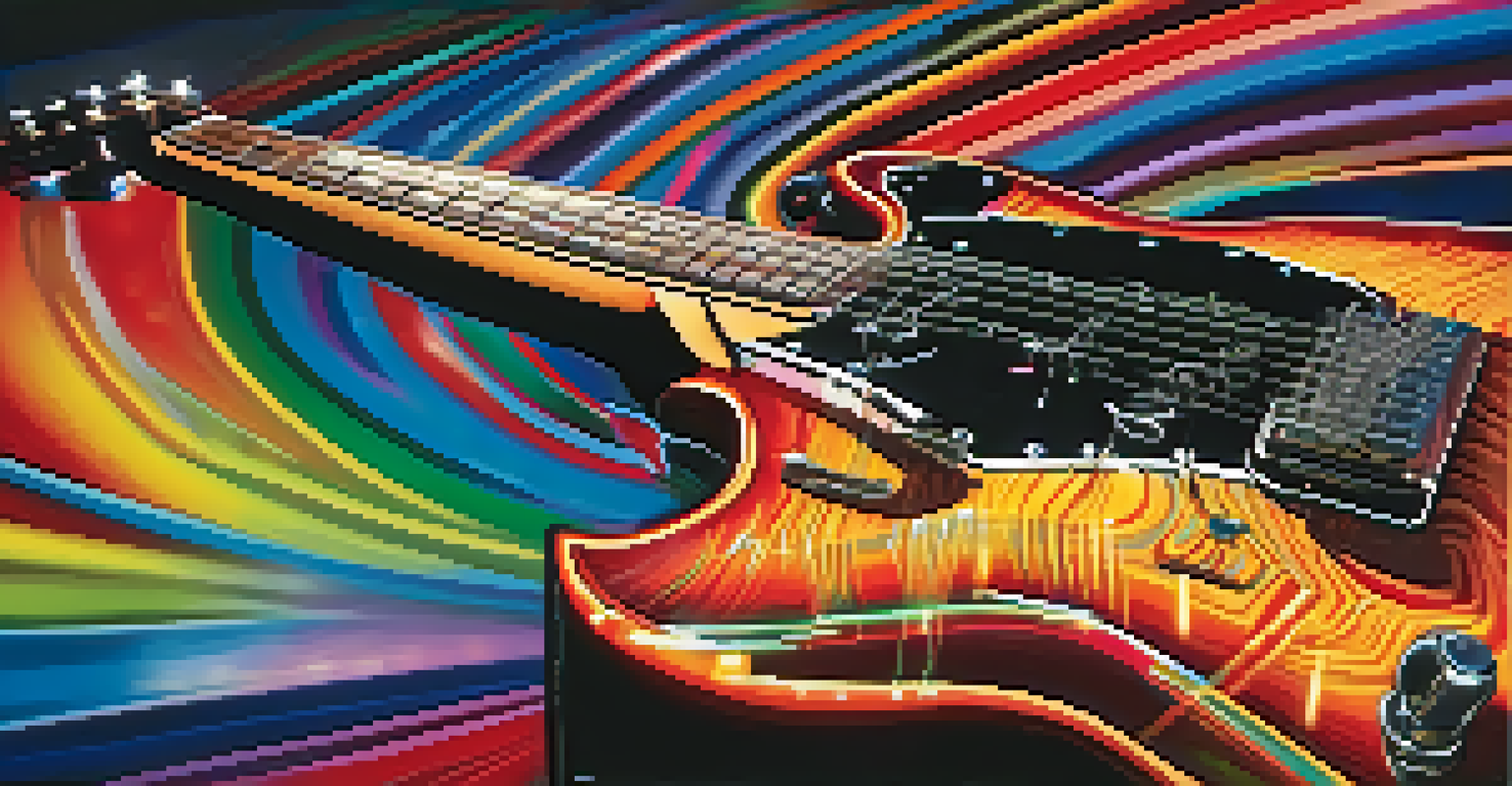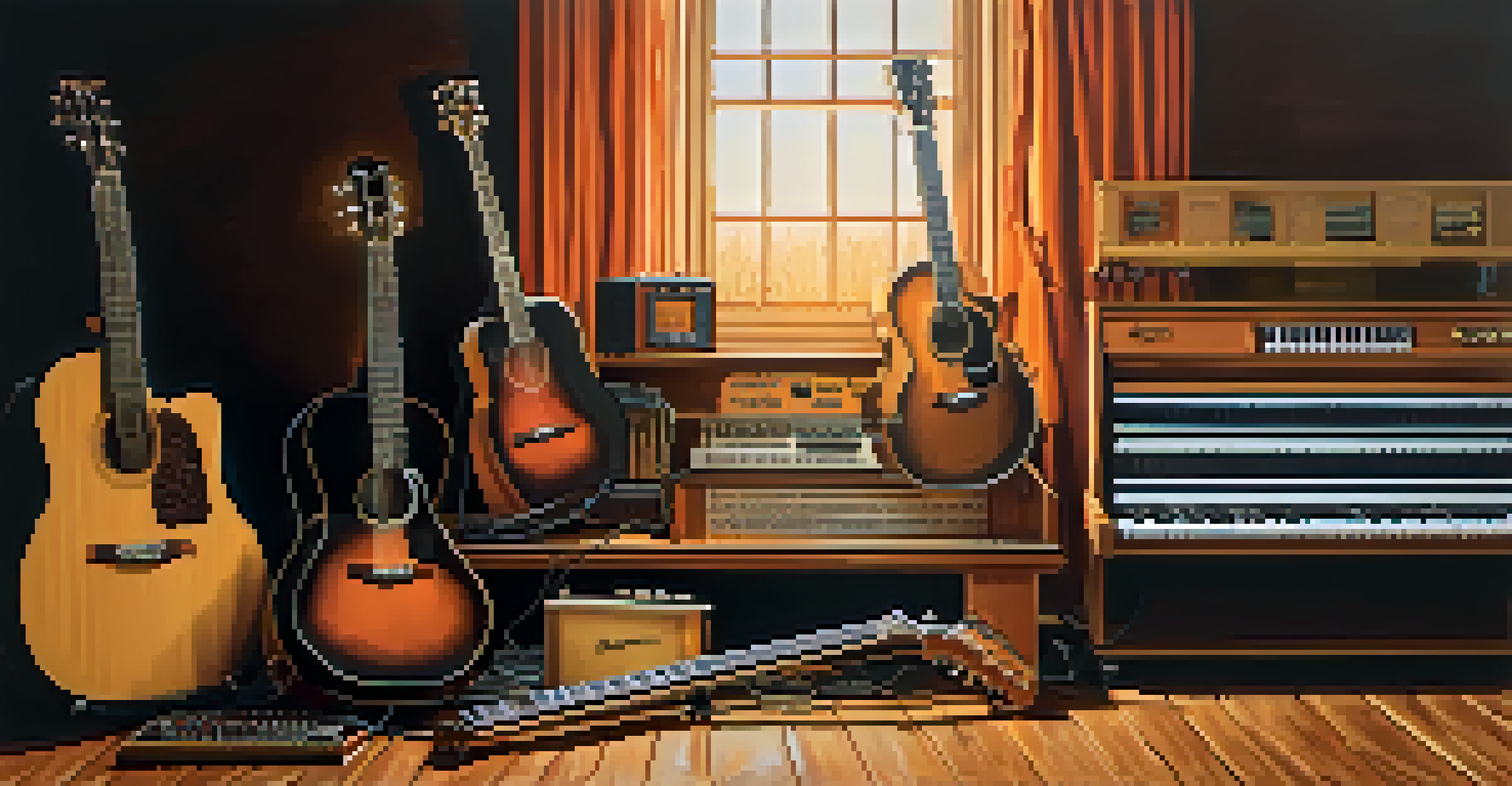Historical Evolution of Acoustic and Electric Music Forms

The Roots of Acoustic Music: A Timeless Tradition
Acoustic music, with its rich history, dates back to ancient civilizations. Instruments like flutes, drums, and stringed devices were crafted from natural materials, allowing people to create sounds that echoed their surroundings. These early forms of music served not just as entertainment, but also as a means of storytelling, cultural expression, and community bonding.
Music is the shorthand of emotion.
As societies evolved, so did their musical styles, reflecting changes in culture and technology. From the development of folk music across various regions to the emergence of classical compositions, acoustic music became a canvas for artistic exploration. Composers like Bach and Beethoven pushed the boundaries of form and harmony, establishing a foundation that would influence generations.
Even in today's digital age, acoustic music retains a special place in our hearts. Whether it's the strumming of a guitar around a campfire or the haunting notes of a violin in a concert hall, the organic quality of acoustic sound continues to resonate with listeners, reminding us of our shared human experience.
The Rise of Electric Music: A Game Changer
The introduction of electricity in the 20th century marked a pivotal moment in music history. Electric instruments, such as the electric guitar and synthesizers, transformed how music was created and experienced. This technological revolution allowed for unprecedented sound manipulation, broadening the horizons of musical creativity.

With the rise of genres like rock, jazz, and electronic music, electric forms began to dominate the musical landscape. Artists like Jimi Hendrix and Kraftwerk harnessed the power of electric instruments to create new sonic experiences that captivated audiences worldwide. The electric guitar became a symbol of rebellion and innovation, shaping the sound of generations.
Acoustic Music's Timeless Appeal
Acoustic music, rooted in ancient traditions, continues to resonate with audiences due to its organic sound and cultural significance.
Today, electric music is at the forefront of popular culture, influencing everything from film scores to dance music. The fusion of electronic elements with traditional acoustic forms has given rise to new genres, showcasing the versatility and continuing evolution of music as an art form.
The Impact of Technology on Music Creation
Technology has always played a crucial role in the evolution of music. From the invention of the phonograph to modern digital audio workstations, each advancement has shaped how artists create and distribute their work. Recording technology, in particular, has revolutionized the music industry, allowing for the perfection of sound that was once unimaginable.
The beautiful thing about music is that it transcends language.
The advent of MIDI (Musical Instrument Digital Interface) in the 1980s allowed musicians to connect various electronic instruments and computers, paving the way for a new era of music production. This innovation enabled artists to experiment with sounds and collaborate remotely, breaking down geographical barriers in the music industry.
In recent years, the rise of streaming platforms has further altered the music landscape. Artists can now reach global audiences with a click, and listeners have access to an endless library of music. While this democratization of music has its advantages, it also raises questions about the value of music and how artists can sustain their careers in a rapidly changing environment.
Blending Acoustic and Electric: A New Frontier
As musical styles continue to evolve, the lines between acoustic and electric music are increasingly blurred. Artists today often blend elements from both forms, creating unique sounds that resonate with diverse audiences. This fusion not only enhances musical creativity but also reflects the interconnectedness of our modern world.
For example, singer-songwriters like Ed Sheeran skillfully merge acoustic guitar with electronic beats, appealing to fans of both genres. Similarly, bands like Mumford & Sons have successfully integrated traditional folk instrumentation with contemporary production techniques, showcasing the versatility of sound.
Electric Music Revolutionizes Sound
The advent of electric instruments transformed music creation and led to the emergence of diverse genres that dominate popular culture today.
This trend towards hybridity invites listeners to explore music in new ways, encouraging a deeper appreciation for the craft. The ongoing dialogue between acoustic and electric forms enriches the musical landscape, ensuring that creativity knows no bounds.
Cultural Influences in Music Evolution
Cultural contexts play a significant role in shaping musical forms. Acoustic music often reflects the traditions, stories, and rituals of specific communities, while electric music tends to encapsulate the zeitgeist of contemporary society. As cultures intermingle, new genres emerge, demonstrating the dynamic nature of music as a cultural artifact.
The influence of globalization has made it easier than ever for artists to share their cultural sounds with the world. Genres like reggae, hip-hop, and K-pop have gained international acclaim, often incorporating elements from various musical traditions to create something entirely fresh. This cross-pollination of styles enriches the global music scene and fosters greater understanding among diverse cultures.
In today's music landscape, it's common to hear a blend of genres that reflect our multicultural society. This evolution not only showcases artistic innovation but also highlights the importance of inclusivity and representation in music, allowing voices from all corners of the world to be heard.
The Role of Live Performances in Music Evolution
Live performances have always been a vital part of music culture, serving as a platform for artists to connect with their audiences. The energy of a live show often transcends the recorded experience, allowing musicians to showcase their talents and creativity in real-time. This dynamic interaction between artist and audience is a hallmark of both acoustic and electric music.
In recent years, live performances have evolved, incorporating advanced technology to enhance the experience. From elaborate light shows to virtual reality concerts, artists are continually pushing the boundaries of what a live performance can be. This innovation not only captivates audiences but also reflects the ever-changing landscape of music as an art form.
Blending Genres for Musical Innovation
The fusion of acoustic and electric elements invites new creative possibilities, reflecting the interconnectedness of modern musical landscapes.
As we move forward, the role of live performances will continue to adapt, integrating new technologies while honoring the traditions of acoustic music. This balance between innovation and heritage ensures that live music remains a cherished experience for generations to come.
The Future of Music: Trends and Predictions
As we look to the future, the evolution of music will likely be shaped by emerging technologies and shifting cultural landscapes. Artificial intelligence is making waves in music composition and production, allowing for new creative possibilities. This technology raises questions about authorship and the essence of human creativity in music.
Additionally, the rise of virtual reality and augmented reality in music experiences suggests a new frontier for artists and audiences alike. Imagine attending a concert where you can interact with the performance in real-time or exploring an immersive music video that transports you to another world. The potential for innovation is limitless.

Ultimately, the future of music will continue to reflect the complexities of our society, merging acoustic and electric elements while embracing new technologies. As artists experiment and evolve, we can expect a rich tapestry of sounds that both honor tradition and pave the way for new musical expressions.